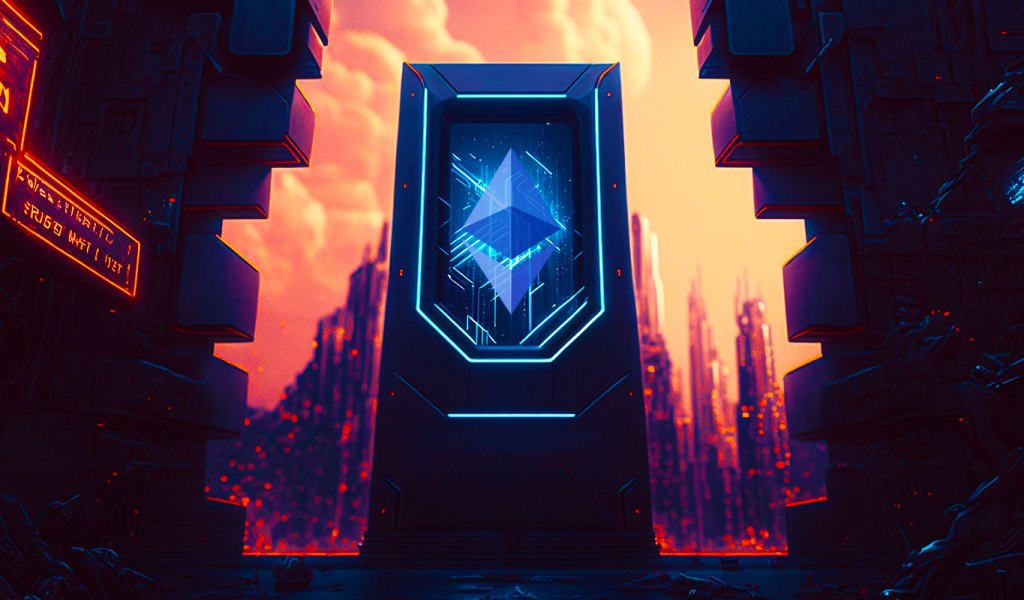 Coinbase plans to transition more customer and corporate Usd coin (USDC) stablecoin accounts to Base, its Ethereum layer two blockchain, aiming for reduced fees and quicker settlement times, as announced by Coinbase VP Max Branzburg. The move is seen by some in the crypto industry as a positive step towards an on-chain financial future, setting […]
Coinbase plans to transition more customer and corporate Usd coin (USDC) stablecoin accounts to Base, its Ethereum layer two blockchain, aiming for reduced fees and quicker settlement times, as announced by Coinbase VP Max Branzburg. The move is seen by some in the crypto industry as a positive step towards an on-chain financial future, setting […]
The total value locked (TVL) in Base, Coinbase’s Ethereum (ETH) layer-2 scaling solution, has hit a new all-time high, reaching nearly $750 million. New data from layer-2 blockchain tracker L2Beat reveals that the TVL of Base is hovering at $742 million at time of writing, a new record high and an exponential rise since July […]
The post Coinbase’s Ethereum Layer-2 Solution’s Total Value Locked Hits New All-Time High, Reaches $742,000,000 appeared first on The Daily Hodl.

Coinbase, the biggest crypto exchange in the US, is listing a new altcoin project built on its proprietary Ethereum (ETH) layer-2. In a new announcement made through the Coinbase Assets account on the social media platform X, Coinbase announces they are listing Seamless (SEAM). According to the Seamless website, the crypto project is the first […]
The post Crypto Exchange Coinbase Lists New DeFi Altcoin Project Built on Base Blockchain appeared first on The Daily Hodl.

Base Bootcamp will offer students weekly meetings with a mentor, a dedicated Discord server, and access to Coinbase and Base engineers, the team stated.
On October 20, the team behind Ethereum layer-2 Base network announced that it's launching an eight-week training course to turn traditional software developers into blockchain developers. Called “Base Bootcamp,” the new program doesn't cost anything to attend. However, it's designed for “mid to senior level Software Engineering individual contributors” and students must fill out an application and be accepted to enroll. Less than 20 students will be accepted into each “cohort” or class, and the team will stop accepting applications on October 27, the announcement stated.
Introducing Base Bootcamp, an eight-week program designed to turn experienced developers into smart contract developers
— Base ️ (@BuildOnBase) October 20, 2023
Base Bootcamp will make learning interactive and collaborative, with support from experienced engineers and dedicated mentorshttps://t.co/gecI1FMpzT
In its announcement, Base claimed the program is necessary because most software developers still do not know how to build Web3 apps. “Today, there are fewer than 30,000 onchain developers,” they stated, “compared to nearly 30 million software developers.” This implies that only 0.1% of software developers work in Web3.
The team released an online training program called “Base Camp” earlier in the year, which was open to anyone. But they decided that this wasn’t enough, as “keeping the momentum to learn a complex new skill alone can be difficult.” They claim that Base Bootcamp will provide more support for developers who don’t want to study alone.
Related: Coinbase open sources code for layer-2 network Base
The Base Bootcamp will pair each student with a mentor who they will meet with each week. It will also give them access to a group of Coinbase and Base engineers who will be available during office hours to answer questions. A private Discord server will be created to allow students to communicate with each other and to Base engineers, and additional assignments will be given that will be graded by members of the team. At the end of the program, students will be required to create their own Web3 app and present it to other students.
Although the program does not charge tuition, students are required to put up 1 Ether (ETH) on deposit to ensure that they finish the program. The team claimed that this deposit will be returned to the student upon graduation.
The lack of qualified Web3 developers is a commonly reported problem in the industry. Some Australian educators have suggested teaching Web3 development in high schools as a means of combating the problem. Other companies have tried to create tools to make Web3 development more simple. For example, Circle recently released a set of tools that allow developers to deploy contracts using familiar Web2 methods.

The code repository of the Coinbase-backed Ethereum (ETH) layer-2 scaling solution Base is now accessible to everyone. In a series of tweets on social media platform X, the team behind the network says all of Base’s contracts and scripts are already publicly available on GitHub. “One of Base’s core values is building in the open. […]
The post Coinbase’s New Ethereum Layer-2 Scaling Solution Open-Sources Smart Contract Code and GitHub Repository appeared first on The Daily Hodl.

As per DeFi Llama data, Solana’s TVL has decreased by 9.64% over the past month to sit at $358.96 million, while Base’s TVL has surged to $397.32 million.
The total value locked (TVL) on Coinbase’s layer 2 network Base has surged to $397.32 million in roughly a month and a half since launching in August. That figure now places Base ahead of the Solana network in terms of TVL, which has $358.96 million at the time of writing.
The past 30 days have been significant for Base, with data from DeFi Llama showing that the network’s TVL increased by a whopping 97.21% over the past month.
In comparison, Solana’s TVL has decreased by 9.64% over that same time frame.

Two Base-native projects account for the largest shares of the TVL on the network.
Decentralized exchange (DEX) Aerodrome Finance takes the top spot with a TVL of $97.83 million, while decentralized social media (DeSo) app Friend.tech ranks second with a TVL of $36.53 million.
Aerodrome was launched on Aug. 28 and it enables users to deposit liquidity to earn AERO tokens, among several other features. While it failed to pull in a significant amount of deposits on its first couple of days, Aerodrome’s TVL skyrocketed on Aug. 31 with $150 million piling in on that day alone.
Its TVL went on to reach as high as $200 million on Sept. 2, however the initial hype appears to have cooled since then, with the TVL decreasing by roughly 51% from its its peak.

Friend.tech launched on Aug. 11 and the platform enables users to tokenize their social networks via the buying and selling of “Keys.” Despite being pronounced as “dead” in late August due to tanking user activity and fees, the platform surged dramatically in September.
As per DeFi Llama, Friend.tech’s TVL increased by 540% over the past month, with most of that coming after a pump that started on Sept. 9 alongside a resurgence in daily trading volume.
Looking lower down the list, Base’s TVL is generally accounted for by multi-network DeFi platforms like Compound, Curve and Uniswap.

Cointelegraph also reported earlier this month that Base hit a new peak in terms of daily transactions, hitting 1.88 million on Sept. 14, according to data from BaseScan.
That figure placed it well ahead of rival chains like Optimism and arbitrum on the day, which had almost 880,000 combined.
Related: Coinbase sought FTX Europe acquisition after bankruptcy: Report
That all-time high remains intact for Base, with daily transactions decreasing to roughly 908,000 as of Sept. 22.

Magazine: Are DAOs overhyped and unworkable? Lessons from the front lines

Analytics firm IntoTheBlock says that major Ethereum (ETH) layer-2 (L2) protocols are evolving and finding their respective niche. IntoTheBlock says that Ethereum-scaling solutions Base, Arbitrum (ARB) and Optimism (OP) are carving out their own paths and creating a “robust and diverse ecosystem.” Looking at Base first, the analytics firm says that Coinbase’s new layer-2 protocol […]
The post Ethereum Layer-2s Witnessing Surge in Specialization as Key Protocols Carve Out Unique Paths: IntoTheBlock appeared first on The Daily Hodl.

Coinbase’s new Ethereum (ETH) layer-2 scaling solution Base set a new all-time high in terms of daily transactions on Thursday. Base skyrocketed to more than 1.8 million transactions on September 14th, shattering its previous record of around 1.4 million, according to the project’s block explorer. The new layer-2 project actually clocked more transactions that day […]
The post New Coinbase Ethereum Layer-2 Surges to New All-Time High in Daily Transactions, Outpacing Arbitrum and Optimism appeared first on The Daily Hodl.

ARB’s price slumps to a new low as a decline in TVL, a decline in active addresses engaging with its DApps and a general malaise across the crypto market take their toll.
Arbitrum has emerged as a leading contender within the Ethereum network’s layer-2 scalability solutions, boasting a significant total value locked (TVL) and notable activity. However, between Sept. 9 and Sept. 11, the price of Arbitrum (ARB) tokens experienced a sharp decline of 14.5%, marking its lowest point in history.
Investors are now eagerly seeking insight into the factors driving this movement and questioning whether Arbitrum still possesses the competitive edge, especially considering that irrespective of the ARB token performance, the network TVL exceeds $1.6 billion.

It is worth noting that the past week has been challenging for most cryptocurrencies, but among Ethereum’s scaling solutions, none experienced a drop exceeding 9%, except for Arbitrum.
One potential source of concern stems from the absence of any instances of fraud proof issuance since the launch of the Arbitrum mainnet in August 2021. Offchain Labs confirmed this information to Cointelegraph on Sept. 4. Developers, however, have explained that this situation aligns with the intended operation of the system, as validators with malicious intentions risk losing their entire stake. Consequently, this data is unlikely to have significantly impacted the price in the past week.
Additional factors that may help elucidate the recent price downturn are associated with governance proposals from Arbitrum's decentralized autonomous organization (DAO). The first proposal, posted on Sept. 2, aims to allocate up to 75 million ARB tokens from the project’s treasury to address “short-term community needs” for active decentralized applications (DApps) within the ecosystem. However, even if approved, this allocation represents less than 2% of the DAO treasury holdings and is unlikely to have triggered the ARB token price correction, regardless of one’s stance on the proposal.
Another governance proposal that has garnered attention was introduced on Sept. 9 by PlutusDAO. This proposal seeks to return tokens from the DAO treasury to ARB holders through the activation of a staking mechanism, creating a native yield for participants, which could involve up to 2% of the total supply annually. Nevertheless, some investors view this inflationary approach as unnecessary and argue that it only exerts downward pressure on prices.
im not a VC so i'd "benefit" from this but..
— PSY (@PSYTWEAK) September 10, 2023
dilution through inflation would be a PVP proposal, instead of trying to bring more value into the ecosystem it extracts it from other ARB holders
Arbitrum is in a good position all round, one of the most popular chains, huge… https://t.co/IDpcdQfQHT
As user Psy highlighted on the X (formerly Twitter) social network, “dilution through inflation” does not contribute positively to the ecosystem, as it merely distributes DAO treasury holdings.
Beyond token governance, there are also concerns related to liquidation risks on both centralized and decentralized exchanges that offer leveraged trading. For instance, Lookonchain has observed a whale withdrawing ARB tokens from the Aave lending platform and transferring some to Binance.
A whale who is long $ARB on #Aave is selling $ARB to repay the debt.
— Lookonchain (@lookonchain) September 11, 2023
Over the past 5 hours, the whale has withdrawn 5M $ARB ($3.85M) from #Aave and deposited 3.8M $ARB ($2.93M) to #Binance.
And the whale currently holds 8M $ARB ($6.16M).https://t.co/HpuZnHbap4 pic.twitter.com/qduKeWC4ul
The challenge with this analysis lies in the ambiguity of cause and effect. Typically, leverage long positions are compelled to close when token prices have already fallen, rather than the reverse. This underscores the importance of investors examining Arbitrum’s activity and deposit trends over the past couple of months, which could have potentially triggered the recent price performance.
Arbitrum's TVL has notably declined to $1.67 billion, marking its lowest level since mid-February.

This 25% decrease over the past two months raises several concerns, primarily indicating a loss of investor confidence. This downturn has the potential to reduce liquidity and undermine the project’s overall viability. Furthermore, it might deter new participants, impeding network growth and adoption.
Next, it's crucial to examine the number of active addresses within the network's top DApps.

There is a noticeable decline in 30-day active addresses, even among well-established DApps like Uniswap, 1inch, Radiant, SushiSwap and GMX. Therefore, when considering the decrease in TVL alongside reduced user activity, it becomes evident that there is a substantial decline in demand for the network. While pinpointing a singular cause for this movement is challenging, one can speculate that competing chains such as zkSync Era and Coinbase’s Base may have contributed.
The data suggests that Arbitrum’s 14.5% correction appears to result from a combination of investor dissatisfaction with the governance mechanism and the network’s lackluster activity, despite offering significantly lower fees compared to Ethereum. Unless there is an upswing in transactions and an expansion of its user base, it is unlikely that ARB will be able to close the price performance gap with its competitors.
This article is for general information purposes and is not intended to be and should not be taken as legal or investment advice. The views, thoughts, and opinions expressed here are the author’s alone and do not necessarily reflect or represent the views and opinions of Cointelegraph.